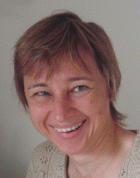Professor Margrit Betke
Margrit Betke, Ph.D. is Associate Professor of Computer Science at Boston University, where she co-leads the Image and Video Computing Research Group, and was a Research Scientist at the Massachusetts General Hospital and Harvard Medical School.
Margrit conducts research in computer vision, in particular, the development of methods for detection, segmentation, registration, and tracking of objects in visible-light, infrared, and x-ray image data. She has worked on gesture, vehicle, and animal tracking, video-based human-computer interfaces, statistical object recognition, and medical imaging analysis.
She has published over 80 original research papers. She received the National Science Foundation Faculty Early Career Development Award in 2001 for developing “Video-based Interfaces for People with Severe Disabilities”. She co-invented the “Camera Mouse”, an assistive technology used worldwide by children and adults with severe motion impairments. She co-developed the first patented algorithms for detecting and measuring pulmonary nodule growth in computed tomography. She was one of two academic honorees of the “Top 10 Women to Watch in New England Award” by Mass High Tech in 2005. She currently leads a 5-year research program to develop intelligent tracking systems that reason about group behavior of people, bats, birds, and cells.
Her current projects include:
- Video-based interfaces for people with disabilities
- Medical imaging
- Object detection, segmentation, and recognition
- Visual observation and analysis of bat behavior
- Intelligent vehicles
- Cell image analysis
Learn about her free software:
- Camera Mouse – a program that enables a person with severe disabilities to control the mouse pointer on the computer screen just by moving the head.
- Camera Canvas – image editing software developed for people with severe motor impairments who cannot use their hands to operate a mouse or keyboard. It can be used with the Camera Mouse or other mouse-replacement tools. Camera Canvas enables users to edit images and draw pictures just by moving their heads.
Margrit coauthored An Information Theoretic Representation of Agent Dynamics as Set Intersections, Dense and sparse aggregations in complex motion: Video coupled with simulation modeling, Explaining Clustered Ventilation Defects Via a Minimal Number of Airway Closure Locations, A Human-Computer Interface Using Symmetry Between Eyes to Detect Gaze Direction, Applications of thermal infrared imaging for research in aeroecology, and Detecting Objects of Variable Shape Structure with Hidden State Shape Models. Read her full list of publications!
She earned her Ph.D. degree in Computer Science and Electrical Engineering at the Massachusetts Institute of Technology in 1995. She holds patent Method and system for the detection, comparison, and volumetric quantification of pulmonary nodules on medical computed tomography scans.
Watch “Camera Canvas” Software Demonstration, Big Meaning in the Smallest Movements, and The Seeing-Eye Mouse. Read her LinkedIn profile. Visit her Facebook page.
